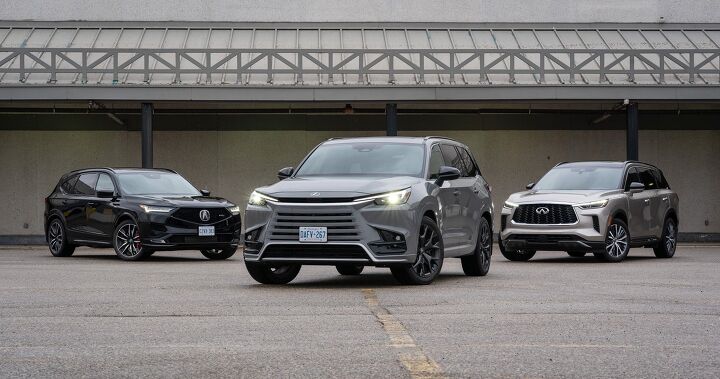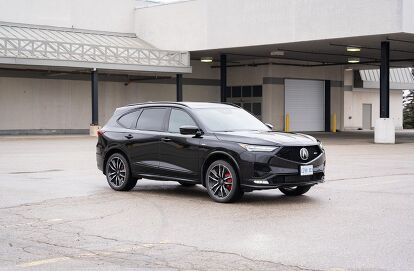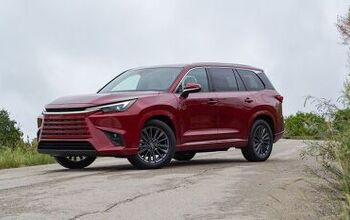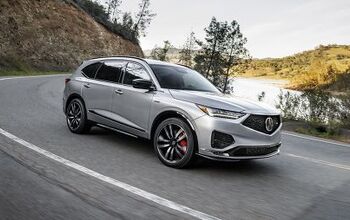Acura MDX vs Infiniti QX60 vs Lexus TX: The X Marks the Spot

Co-Written by Mike Schlee and Jeff Wilson
The Lexus lineup had a big hole to plug.
Three-row luxury SUVs are big business, yet even though the Japanese brand had two answers to the question—the stretched RX-L, and the rugged GX—neither ever quite seemed the right one.
The new-for-2024 TX aims to change that. With a larger footprint than any unibody Lexus SUV to come before it, the TX promises to shuttle six in comfort, and all the assorted flotsam and jetsam that comes with that. We were impressed enough with the new model at its launch late last year, so we had to get it together with its countryman on home turf to really see how it stacks up. Jumping in to help us wrangle the Lexus, Acura MDX, and Infiniti QX60 is regular AutoGuide contributor—and fellow TX launch event attendee—Jeff Wilson.
Acura MDX Type S
Words by Kyle Patrick
After picking up the 2024 Acura MDX Type S, it takes just a few hundred feet for me to declare it incapable of winning this comparison. A few corners later, I'm singing its praises.
This is the MDX Type S experience in a nutshell: it swings between fantastic and frustrating, satisfying and stultifying. It is the most compromised of this trio of three-rows, and that limits its all-round appeal. That being said, depending on your specific set of needs, it could be far and away the right choice.
Heart of an Athlete
On paper, the MDX might be down on power, but to drive, this is easily the most fun of the group. The Type S ditches the tried-and-true 3.5-liter V6 that has been a staple of MDX models for years, and drops in a twin-turbo 3.0-liter instead. Horsepower sits at a solid 355 horsepower, with 354 pound-feet of torque available through much of the rev range. A 10-speed automatic ably handles shifting duties. Acura's trick SH-AWD system is standard.
Where the TX feels confused and the Infiniti is just too relaxed, the MDX has put on its running shoes. The powertrain is effortlessly muscular, propelling the comparative mid-weight of this group forward with ease. The 10-speed is a mixed bag: in the default drive mode it almost acts like a CVT, trying to slur the gears as much as possible. The adaptive suspension—unique amongst this trio—allows the MDX to maintain a surprisingly docile ride despite its ample 21-inch rolling stock.
Twist that spotlight drive selector over to Sport and the whole SUV gets comfortable in its skin. The transmission holds gears for longer, while the suspension hunkers down. Steering weight and feedback are the best here, making it easy to glean what the big SUV is up to. The SH-AWD system gives the MDX a more neutral stance through corners, making it the most fun to hustle here.
Does that matter to three-row buyers? To most, probably not. But there aren't a lot of options to mix performance and three rows at this price.
Focused cabin
The MDX's central dashboard design should make it clear where its priorities lie. Instead of the usual storage cubby or cupholder spot, the MDX drops in a massive drive mode selector and a protruding push-button shifter. The former is a fun bit of theater sure, with slick accompanying visuals in main screen, and changes to the driver instrument panel too. But that push-button shifter is my initial source of frustration. No two buttons are the same, which is theoretically good for muscle memory, but requires second-guessing for something like a three-point turn.
Shifter foibles aside, the MDX cabin itself is quite nice. Material quality is very good, with soft-touch materials aplenty, an ultrasuede headliner, and tasteful bits of dark wood. There's a substantial swathe of piano black, but since it's not a spot that requires regular prodding, we're not too bothered. We appreciate the wrist rest ahead of the infotainment controls—if not the infotainment itself, which is a subject for later. Still not sure what the micro-cubby beside the equally diminutive volume knob is for, though.
Seat comfort is an MDX high point, especially as the front seats feature a massage function. The second row is solid too, with the only middle bench of the bunch featuring good back- and thigh support. It's the third row that hurts the MDX's chances here. Not only is it a tight fit for adults, but the trimmings and amenities are decidedly low-rent against the Lexus and Infiniti.
Irksome infotainment
The demerits continue with the MDX's infuriating non-touchscreen. In theory, the trackpad controls make sense, mapping quadrants to on-screen selections for minimal scrolling. The problem is that a vehicle is usually in motion. A well-timed bump in the road is all that's needed to make a wrong selection, or even just a second morning coffee. Apple CarPlay changes things up again, turning touchpad functionality into the same as that of any laptop.
Acura seemingly acknowledges the issue here, as the company has already confirmed a touchscreen is coming in for '25. But that's not of any use to us here in the present.
The rest of the tech suite fares better. The excellent ELS audio system is the best of the test, with crisp highs and distortion-free bass. A head-up display provides pertinent info right in the driver's field of vision. Acura's digital instrument cluster is sharp and easy to read, and includes a useful graphic of the car for adaptive cruise.
Speaking of, the MDX comes loaded with all manner of safety assists. Its adaptive cruise control proved excellent on highways, needing no adjustments. A 360-degree camera is highly detailed to ensure you don't scratch those pretty alloys, too.
Pricey fun
The MDX's final stumbling block? Its price. The as-tested price of this loaded Type S sits dangerously close to being the most-expensive model here, coming in at over $75,000 US (or $88,000 CAD).
As a performance-oriented three-row, that's still thousands less than you'll find an equivalent German model for. But here, the Acura's performance chops don't make up for its poor third-row experience and clunky user interface.
Infiniti QX60 Autograph AWD
Words by Jeff Wilson
Imagine for a moment, these three crossovers are characters in a mid-80s John Hughes film. You’d have the sporty kid dressed in track pants and a tank top, constantly flexing – that’s the Acura. There’d be the nerdy kid, obsessed with sci-fi – that’s clearly the hybrid Lexus. And then we’d have the handsome rich kid, all dignified and quiet, but with a hidden secret – that’s the Infiniti.
The plot twist is that the suave rich kid, isn’t a rich kid at all, he just plays the part. With the QX60 ringing the till some ten grand less than the other two characters here (and nearly $20,000 less in Canada), Infiniti’s top-spec QX60 is a bargain compared to the other two.
Costing less is one thing, but the QX60 looks anything but cheap. From any angle, the Infiniti offers a less trendy, more dignified elegance missing from the other two. Having the smallest wheels (20-inchers), and a surprising abundance of flashy chrome trim only reinforces that the Infiniti isn’t trying too hard to be something it’s not (yes, TX, we’re looking at you and your inappropriate F-Sport trim and Star Wars front end). The Infiniti’s champagne-hued paint was positively liquid in depth and lustre, while the contrasting black roof hints at Range Rover style, which is never a bad thing.
Proper Premium Interior
But as pleasing as the QX60’s exterior is, it’s the cabin of our top-of-the-line Autograph tester that wowed our reviewers. The semi-aniline leather with its quilted stitching, gives a very positive first impression. Then one notices those cognac-coloured hides are dramatically offset by a wide swath of black-stained, open-pore wood and subtle aluminum trim. It’s both tasteful and striking, and immediately helps remind a buyer they’ve splashed out for a premium-brand product. It feels special in the QX60.
Those seats not only look great, but they’re the most comfortable of the lot, too, with luxurious suppleness, yet firm and supportive enough for long trips. The thick-rimmed steering wheel feels good in-hand, and its myriad of controls are all sensibly laid out. The same can be said for the rest of the QX60’s ergonomics that benefit from simple knurled dials for temperature and volume controls, while the dash-top 12.3-inch infotainment display offers touch screen operation.
We weren’t thrilled with the span of haptic panel buttons for some of the audio and climate controls, especially since they get so easily smudged with greasy finger prints, marring the otherwise lovely cockpit.
Smaller Space
Infiniti’s infotainment system offers standard wireless Apple CarPlay and Android Auto, as well as on-board Wi-Fi, plus baked-in navigation and a decent 17-speaker Bose audio system (that’s not as rich and powerful as Acura’s excellent ELS system). Of course, operating the QX60’s infotainment system is easier than the Lexus’s slightly more complex series of menus, and dramatically better than the downright infuriating Acura track-pad system.
Second-row passengers are treated to a pair of captain’s chairs with a removable console between them. Third row occupants get a more hospitable space than the MDX thanks to larger windows, and arm rest trim that’s got a bit of padding on them. On paper, the QX60’s third row measures smallest in terms of available leg and headroom, but both Michael and Kyle found it comparable to the MDX for space when sequestered back there, though it’s notably smaller than the TX’s. The Infiniti’s cargo space, whether measured behind the third row, or with second and rear seats folded flat, is smallest, too.
Smooth Operator
Displacing 3.5L, the Infiniti’s V6 is the largest engine in the test, but without the help of turbos like the Acura, or electrification like the Lexus, it’s also the least powerful, producing a still-respectable 295 hp. The torque deficit is more significant, with its 270 ft-lbs easily eclipsed by the MDX’s 354 lb-ft and the TX 500h’s tractor-like 406 lb-ft. Even still, around town, the Infiniti had no trouble keeping up with the other two, puttering around from stoplight to stoplight, and really only falling behind at higher speeds when merging on the highway or passing. The Infiniti’s relative lack of power doesn’t hurt its hauling ability with the only 6,000 lb tow rating in the group.
The Infiniti’s 9-speed automatic does a good job in that the driver is largely unaware of its existence. It goes about its business smoothly and quietly, and with smart gearing, helps keep the QX60 feeling suitably spritely. Steering feel is virtually non-existent, and the handling is suitable for a 3-row bus like this, which is to say, it’s not going to be mistaken for a sports wagon, but it manages itself well enough. The Autograph trim also benefits from additional sound deadening, making our tester impressively serene, even when goading the engine to keep up with its more powerful competitors.
John Hughes always managed to make us fall for the kind, thoughtful, well-rounded kid who came through in the end, and that’s the case with this likeable QX60. While not the biggest, flashiest or strongest, it’s a consistently solid contender across the board, pampering its occupants in a proper, premium cabin. Factor in its strong value quotient, and the Infiniti becomes a great choice within the segment.
Lexus TX 500h
Words by Mike Schlee
The Lexus TX is the new kid in town, and one of the biggest. Parked next to the MDX and QX60, the TX looks an entire class larger, even though that’s not the case. Chalk it up to the squared off rear-end and blunt, tall front end.
Currently, the TX can come with a choice of two engines, while a third plug-in hybrid unit is on the way later this year. As of now, the biggest engine option is found in the TX 500h. It contains the 2.4-liter turbocharged four-cylinder paired to a hybrid electric system. As has already been mentioned, the TX 500h is the power champ here with 366 combined horsepower and 406 lb-ft of torque.
Topic of Power and Sound
On the road, the hybrid system does a commendable job getting the big TX up and going. It feels more torque-rich at all speeds than the Infiniti QX60, but not as responsive or as eager as the MDX Type-S. We also commend Lexus for including a conventional transmission, a 6-speed automatic, with the hybrid set-up.
Where the drivetrain falters a bit is with sound. In every driving mode other than Sport, the TX 500h emits an unmasked, subtle groan from the four-cylinder engine. In a vehicle this richly premium inside, with a price tag to match, it takes a bit away from the driving experience. The best way to describe it probably came from one of our passengers who stated it was underwhelming and felt down-market.
The good news is, in Sport mode, the synthetic engine noise is pumped through the speakers giving it a deeper, beefier, mellow tone. But it only happens in that mode, or in the custom drive mode if the Sport drivetrain is selected. We wish there was an independent option somewhere in the menu to turn the sound off or on.
The In-Betweener
The rest of the TX 500h mechanics are well put together and properly tuned for a luxury rig designed to haul passengers. Comfort falls in-between the MDX and QX60 as the TX is more comfortable to drive than the MDX but doesn’t quite match the QX60’s serene driving experience.
Part of this may be due to the tester we received, which is a 2024 Lexus TX 500h F Sport Performance Luxury AWD. In Canada, it’s a bit less of a mouthful, as it’s simply called the Lexus TX 500h, with the $6,000 F Sport Performance 3 package added on.
As the trim suggests, the TX adorns various F Sport badging inside and out. The massive 22-inch wheels wearing 255/45R22 tires look purposeful and ready for action. But this is not a performance SUV, even if there is the puzzling addition of a digital g-force meter include in the driver information center.
Don’t get us wrong, it is perfectly composed when cornering, and feels more connected to the road than the QX60. Compared to the Acura MDX Type-S though, it’s more of a luxury passenger hauler than mildly entertaining driver’s SUV.
Abundance of Space
Being the largest vehicle on hand, it’s not surprising that the TX 500h offers the most space. With the squared off rear roofline, there’s more usable cargo capacity than the other two, especially when it comes to taller objects. The only detriment is the load floor that does sit a bit higher off the ground, most likely due to the hybrid system.
Inside, the front two rows of passengers enjoy supple leather seats with various birch trim bits surrounding them. In front of the driver resides a customizable information center and head-up display. The 14-inch infotainment system drew mixed reviews in terms of usability, but the 21-speaker Mark Levison audio system was a hit.
The third-row seats of the TX 500h are easily the most accommodating although we still wouldn’t subject adults back there on longer voyages. Head room is ample, but the seat cushion is a bit low while legroom is wholly dependent on where the second-row passengers situate their seat.
Model Employee, at a Price
The Lexus TX 500h is designed to be a premium, large people hauler and it performs this task admirable. It’s blends comfort and response, while treating all occupants to a mostly enjoyable driving experience.
We want to be clear on this, it is the best overall vehicle here. But there are two obstacles hindering the TX from a runaway victory.
First, there’s the styling. Although beauty is in the eye of the beholder, none of us are sold on this new look, and in time we feel it won’t age well either. The other issue, as Jeff alluded to, is price. As tested it is more expensive than the other two offerings, significantly so compared to the QX60.
The Verdict
All three of these three-row SUVs impressed us in different ways. Be it the athletic nature of the MDX, the swishy sumptuousness of the QX60, or the TX's appealing combo of fuel sipping and stretch-out space, each of these premium offerings have their strengths.
When we sit down to rank them, it's the Acura that comes up last—with a caveat. As handsome as it is, and as satisfying as it can be down a good backroad, the MDX is simply not as good at hauling folks as the others. What's more, its infotainment and shifter are infuriating in equal measure. If you absolutely, positively must have a three-row that also doubles as your main grin machine, the Type S does it better than most other options under six figures.
It might be the newest kid on the block, but the Lexus TX has to settle for silver here. Lexus deserves credit for listening to feedback and creating a dedicated three-row that is both spacious and comfortable. The brand's hybrid approach continues to offer buyers plenty of power while retaining better fuel economy, too. The F Sport treatment lets the big Lexus Texas down, however, with a muddled personality and a very steep price tag.
Thus it's the QX60 that sneaks in to grab the top spot. The undisputed dark horse of this comparison, the QX60 is vastly more affordable yet features the most special cabin. Sure, it's down on power and agility compared to the others, but the more relaxed vibe only encourages drivers to slow down and appreciate the good in life. Use the savings to take the family on vacation—after all, they're worth it.

Kyle began his automotive obsession before he even started school, courtesy of a remote control Porsche and various LEGO sets. He later studied advertising and graphic design at Humber College, which led him to writing about cars (both real and digital). He is now a proud member of the Automobile Journalists Association of Canada (AJAC), where he was the Journalist of the Year runner-up for 2021.
More by Kyle Patrick





























































































































Comments
Join the conversation
Hahaha A Nissan product wins. NO comment
I totally agree on the outcome. Imo, the Infiniti is the best looking of the 3. The Lexus seems unfinished to me. BTW, I am not a Grand Highlander fan, either. I would consider myself a 'Honda (& Mazda) Guy' over Toyota and Nissan, but the Acura doesn't interest me at all. In fact, there should have been a 4th entrant, the Mazda CX90. I think it would have swept every category.